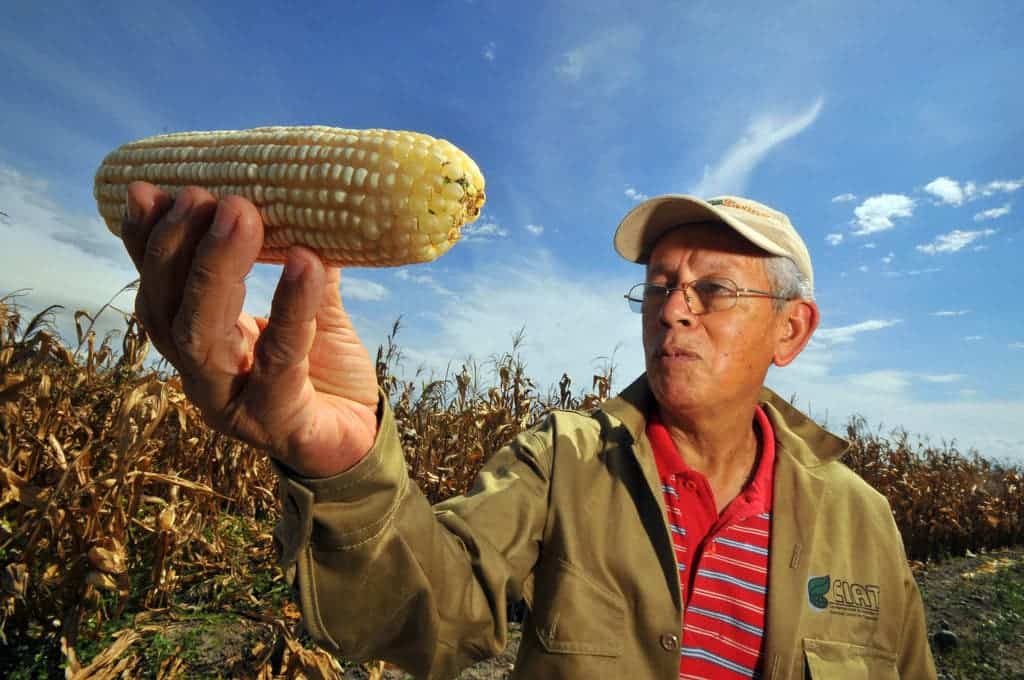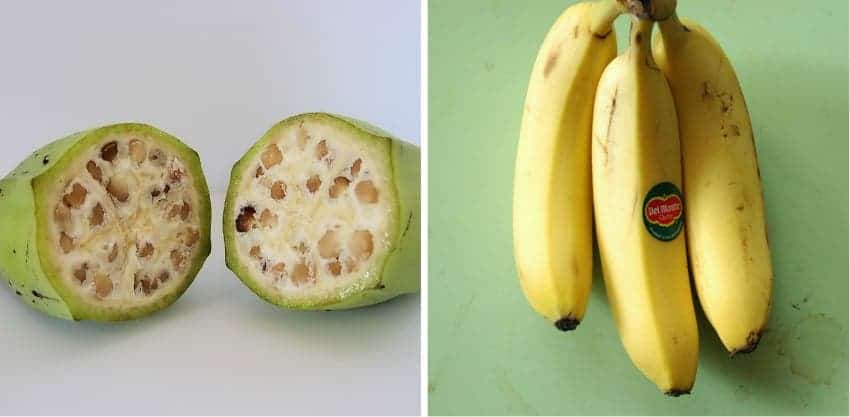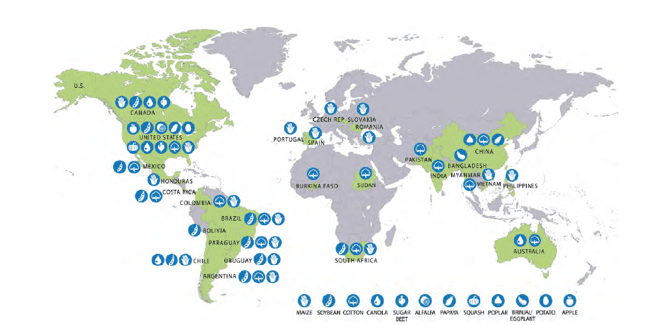
Genetically modified organisms (GMOs) are hotly debated all around the world. Many people are very concerned about engineering crops and animals because of the long-term effect this might have on our planet and our bodies. It’s no wonder then that the opinions people have about GMOs are so polarizing.
The majority of foods in the United States can be classed as genetically modified food because they contain at least one genetically modified ingredient. The genetic modification most often involves introducing a desirable trait to a plant, such as increased resistance to pests, by inserting genes from a foreign organism, such as a bacteria. Many crops grown in the U.S., like most of the soybean, corn, cotton, and canola, are grown from genetically engineered seeds.
According to a 2016 survey conducted by the Pew Research Center, “about half of Americans (48%) say the health effects of GM foods are no different than other foods, 39% say GM foods are worse for one’s health and one-in-ten (10%) say such foods are better for one’s health.” About one in six Americans are deeply concerned with GMOs and predominantly believe GM foods pose health risks.
What genetic modification is and how it works
Genes are bits of DNA which determine all sorts of traits and characteristics in any organism, from size to what chemicals certain cells express. Some genes offer traits that allow certain animals or plants to thrive in their environment, so these genes will be passed along. In time, with many generations, these genes will become common in the population. Our ancestors unwittingly sped up this process when they saved the seeds of the best crop plants to grow them next time, and the next, and the next.
That’s how tiny kernels on tall grass were turned into the juicy corn on the cob over 10,000 years of selection. With animals, we’ve “improved” or domesticated various species by selecting those individuals that had the best desirable qualities, from being compliant to our commands to yielding more milk. Here are a couple examples of wild vs selected crops.




So ever since the first hunter-gathers transitioned to a sedentary lifestyle, humans have been genetically modifying plants and animals around them by cross-breeding and selecting the most desirable traits in organisms.
However, the kind of modern genetic modification taking place today is different, in the sense that scientists can precisely target genes or set of genes. With selective breedings, all the traits of the desirable animal or plant are passed on to the new offspring. But this also means you get a lot of ‘junk’ — traits that you don’t really need — and the process takes a long time, over many breeding iterations, until you come up with the desired traits. Selective breeding also only works with organisms that are closely related, such as two varieties of corn.
To make a GM plant, scientists first isolate DNA from different organisms, which can be totally unrelated, such as bacteria, viruses, or even humans. Then, these genes are biochemically recombined in the lab to make a “gene construct”, which can consist of DNA from five to fifteen different organisms. The gene construct is then closed in bacteria so scientists have a lot of copies to work with. The isolated copies are inserted into embryonic plant tissue or migrated directly into plant tissue via a bacterium that acts as a vector. Ultimately, only a few plants out of hundreds will grow normally and exhibit the desired traits, like herbicide resistance, for instance.
Are GMOs safe?
Despite the public having polarized opinions on the safety of GMOs, scientists overwhelmingly agree that GMOs pose no hazard to consumers. In sharp contrast to public views about GMOs, 89% of scientists from the American Association for the Advancement of Science (AAAS) believe genetically modified foods are safe, the Pew Research Center study found.
The AAAS scientists say that media hype can explain the huge gap in opinion about GMOs between their views and that of the public. About 79% of the scientists surveyed by Pew Research said that the media doesn’t distinguish between “well-founded” and “not well-founded” science. What’s more, 52% of the questioned scientists think that the media oversimplifies the science.
“There are several current efforts to require labeling of foods containing products derived from genetically modified crop plants, commonly known as GM crops or GMOs. These efforts are not driven by evidence that GM foods are actually dangerous. Indeed, the science is quite clear: crop improvement by the modern molecular techniques of biotechnology is safe. Rather, these initiatives are driven by a variety of factors, ranging from the persistent perception that such foods are somehow “unnatural” and potentially dangerous to the desire to gain competitive advantage by legislating attachment of a label meant to alarm. Another misconception used as a rationale for labeling is that GM crops are untested,” reads an AAAS statement.
The AAAS also signed a joint statement that debunks claims from anti-GMO advocacy groups that suggest GM foods are less tested or nutritious than non-GM foods.
“Contrary to popular misconceptions, GM crops are the most extensively tested crops ever added to our food supply. There are occasional claims that feeding GM foods to animals causes aberrations ranging from digestive disorders, to sterility, tumors and premature death. Although such claims are often sensationalized and receive a great deal of media attention, none have stood up to rigorous scientific scrutiny. Indeed, a recent review of a dozen well-designed long-term animal feeding studies comparing GM and non-GM potatoes, soy, rice, corn and triticale found that the GM and their non-GM counterparts are nutritionally equivalent,” the AAAS said.

According to an exhaustive analysis of the current scientific literature on the subject (over 900 studies published in the last two decades), there is “no substantiated evidence of a difference in risks to human health between current commercially available genetically engineered (GE) crops and conventionally bred crops.” The 2016 study published in the National Academies of Science, Engineering, and Medicine, also concludes that there is no conclusive evidence linking GMOs to environmental problems.
The main takeaways from what’s perhaps the most comprehensive report so far are:
- Genetically engineered (GE) crops are safe to consume. That’s to say, there is no evidence that suggests GM food harms human health, increases food allergies, affects the gastrointestinal tract, or poses any risk for horizontal gene transfer.
- GE crops introduced in the food system today don’t increase crop yields directly. However, they protect yields from insects and weeds.
- Herbicide-tolerant crops and those with Bt pesticide built in require less pesticide use.
- Glyphosate use, the herbicide which GE crops can tolerate, has caused the adaptation of glyphosate-resistant weeds, which can cause farmers a lot of expensive problems.
- There is no evidence pointing to adverse effects or danger to biodiversity from interbreeding GE crops with wild counterparts.
- Farmers largely earn more from GE crops, but individual results vary.
- Small-scale farmers may not see economic gains due to the price of seeds and difficulty accessing credit.
- Regulation of food crops should be mandatory, but based on the characteristics of the crop, rather than the technique used to develop it, be it GE or non-GE.
- GE debate should be transparent and with public participation.
While the committee concludes that “no differences have been found that implicate a higher risk to human health and safety from these GE foods than from their non-GE counterparts,” it did include a caveat in the report stating any food, GE or otherwise, “may have some subtle favorable or adverse health effects that are not detected even with careful scrutiny and that health effects can develop over time.”
GE crops are the most researched and tested agricultural products in history. In the United States, such products are tested time and time again for consumer and environmental safety by the U.S. Department of Agriculture, the Environmental Protection Agency and the Food and Drug Administration. The same goes for the European Union which conducts tests through its own regulatory bodies. Every major scientific body in the world that has reviewed research on GMOs state that GMO production and sale is safe.
But despite this body of evidence, genetic engineering in agriculture will continue to be a topic debate for decades to come — and that might actually be a very good thing. Even though progress might be hindered, if GE foods are indeed harmful in some way, either to human health or the environment, they deserve the utmost scrutiny. However, at the end of the day, if you’re skeptical of GE food, you should also have this skepticism rooted in scientific consensus, rather than some debunked myth.


